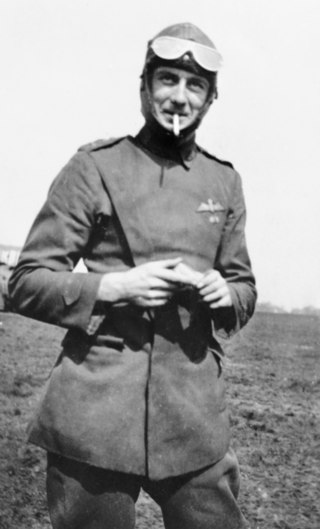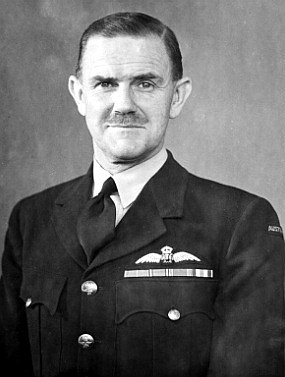
William Ellis Newton,VC was an Australian recipient of the Victoria Cross,the highest decoration for gallantry in the face of the enemy that can be awarded to a member of the British and Commonwealth armed forces. He was honoured for his actions as a bomber pilot in Papua New Guinea during March 1943 when,despite intense anti-aircraft fire,he pressed home a series of attacks on the Salamaua Isthmus,the last of which saw him forced to ditch his aircraft in the sea. Newton was still officially posted as missing when the award was made in October 1943. It later emerged that he had been taken captive by the Japanese,and executed by beheading on 29 March.

Central Flying School (CFS) is a Royal Australian Air Force (RAAF) training unit,located at RAAF Base East Sale,Victoria. It operates the Pilatus PC-21 turboprop trainer. The school is responsible for training flight instructors,setting flying standards,and auditing flying practices. It is also home to the "Roulettes" aerobatic team. CFS was the first military aviation unit to be formed in Australia,in 1913,when its role was to provide basic flying training. Its current form dates from World War II,when it was re-established to train flying instructors for the Empire Air Training Scheme (EATS).

Stanley George Sismey was an Australian cricketer. Sismey,who achieved the rank of Squadron Leader in the Royal Australian Air Force (RAAF) during World War II,was the official Commanding Officer of the Australian Services XI that played England in the Victory Test series that followed VE Day in 1945. He was not,however,the on-field captain,an honour bestowed upon pre-war Test cricketer Lindsay Hassett. Sismey was the team's wicketkeeper and a middle order batsman during the five unofficial Test matches.

Air Marshal Sir George Jones,was a senior commander in the Royal Australian Air Force (RAAF). He rose from private soldier in World War I to air marshal in 1948,and served as Chief of the Air Staff from 1942 to 1952,the longest continuous tenure of any RAAF chief. Jones was a surprise appointee to the Air Force's top role,and his achievements in the position were coloured by a divisive relationship during World War II with his nominal subordinate,the head of RAAF Command,Air Vice-Marshal William Bostock.

Sir David Eric Fairbairn,was an Australian politician. He was a member of the Liberal Party and served in the House of Representatives from 1949 to 1975. He held ministerial office as Minister for Air (1962–1964),National Development (1964–1969),Education and Science (1971),and Defence (1971–1972).

Sir Thomas Walter White,was an Australian politician and pilot in the First World War. In 1914 he became one of the first airmen trained for the Australian Flying Corps (AFC),and the following year he was among the first AFC members to see action when he was deployed to the Middle East with the Mesopotamian Half Flight. After carrying out several missions behind Turkish lines,he was captured in November 1915 but escaped in July 1918. White was awarded the Distinguished Flying Cross and twice mentioned in despatches for his war service. He married Vera Deakin,a Red Cross worker and daughter of former Australian prime minister Alfred Deakin,in 1920.

Air Vice-Marshal William Hopton Anderson,was a senior commander in the Royal Australian Air Force (RAAF). He flew with the Australian Flying Corps in World War I,earning the Distinguished Flying Cross and the Belgian Croix de guerre for his combat service with No. 3 Squadron on the Western Front in 1917. The following year he took command of No. 7 (Training) Squadron and,later,No. 3 Squadron. Anderson led the Australian Air Corps during its brief existence in 1920–21,before joining the fledgling RAAF. The service's third most-senior officer,he primarily held posts on the Australian Air Board in the inter-war years. He was appointed a Commander of the Order of the British Empire in 1934,and promoted to air commodore in 1938.

Air Marshal Sir John Patrick Joseph McCauley,KBE,CB was a senior commander in the Royal Australian Air Force (RAAF). He served as Chief of the Air Staff from 1954 to 1957. A Duntroon graduate,McCauley spent four years in the Australian Military Forces before transferring to the RAAF in 1924. He was Director of Training from 1936 to 1938,and commanded engineering and flying training schools for the first eighteen months of World War II. Having been promoted to group captain in 1940,he was posted to Singapore in June 1941 to take charge of all RAAF units defending the area. He earned praise for his efforts in attacking invading Japanese forces before the fall of Singapore,and for his dedication in evacuating his men. After serving as Deputy Chief of the Air Staff in 1942–1944,he was appointed to a senior operational role with the Royal Air Force's 2nd Tactical Air Force in Europe,where he saw out the rest of the war.

Robert George Halverson,was an Australian politician,air force officer and diplomat. He was a member of the House of Representatives from 1984 to 1998,representing the Liberal Party. He was Speaker of the House from 1996 to 1998,and subsequently served as Ambassador to Ireland from 1998 to 2003.

Leonard William Hamilton was an Australian politician. Born in Jarrahdale,Western Australia,he was educated at Perth Boys School before becoming a wheat and sugar farmer. He served in the military from 1917 to 1920 and from 1940 to 1945. In 1946,he was elected to the Australian House of Representatives as the Country Party member for Swan,defeating Labor MP Don Mountjoy. In 1949,he transferred to the new seat of Canning,where he remained until his retirement in 1961. Hamilton later served as President of the Western Australian branch of the Country Party. He died in 1987.

Peter Grahame Browne was an Australian Federal politician. Born in Sydney,he enlisted in 1940 and served with the 2nd AIF as a Gunner in the 14th Heavy Anti-aircraft Battery in Darwin during the Bombing of Darwin from February 1942. In 1943 he transferred to the RAAF to undertake pilot training through the Empire Air Training Scheme,initially at 2 Initial Training School Bradfield Park,Sydney. He was medically discharged from the RAAF after suffering from mastoiditis.

Earl Douglas Cash was an Australian politician. He was a member of the Liberal Party and served in the House of Representatives from 1958 to 1961,representing the Western Australian seat of Stirling. He was defeated after a single term but later served in the Western Australian Legislative Assembly from 1968 to 1971,representing the seat of Mirrabooka.

Ronald Davies was an Australian politician. He was a member of the Australian Labor Party (ALP) and served in the House of Representatives from 1958 to 1975,representing the Tasmanian seat of Braddon. He was a schoolteacher before entering politics.

Victor Seddon Vincent was an Australian politician. Born at Leonora,Western Australia,he was educated at Scotch College in Perth,and then the University of Western Australia,becoming a barrister. He practiced in Kalgoorlie from 1931. After serving in World War II (1939-1945),he was a member of Kalgoorlie Municipal Council,and President of the Kalgoorlie Chamber of Commerce. In 1949,he was elected to the Australian Senate as a Liberal Senator for Western Australia. He held the seat until his death in 1964;Peter Sim was appointed to replace him.

Air Marshal Sir Charles Frederick Read,KBE,CB,DFC,AFC was a senior commander in the Royal Australian Air Force (RAAF). He served as Chief of the Air Staff (CAS) from 1972 to 1975. Born in Sydney,Read joined the RAAF in 1937,and began his career flying biplane fighters. As a Beaufighter pilot,he led No. 31 Squadron and No. 77 Wing in the South West Pacific during World War II. His achievements earned him the Distinguished Flying Cross and a mention in despatches,and he finished the war an acting group captain.

Air Vice Marshal Adrian Lindley Trevor Cole,CBE,DSO,MC,DFC was a senior commander in the Royal Australian Air Force (RAAF). Joining the army at the outbreak of World War I,he transferred to the Australian Flying Corps in 1916 and flew with No. 1 Squadron in the Middle East and No. 2 Squadron on the Western Front. He became an ace,credited with victories over ten enemy aircraft,and earned the Military Cross and the Distinguished Flying Cross. In 1921,he was a founding member of the RAAF.

Air Vice-Marshal Francis Masson Bladin,was a senior commander in the Royal Australian Air Force (RAAF). Born in rural Victoria,he graduated from the Royal Military College,Duntroon,in 1920. Bladin transferred from the Army to the Air Force in 1923,and learned to fly at RAAF Point Cook,Victoria. He held training appointments before taking command of No. 1 Squadron in 1934. Quiet but authoritative,he was nicknamed "Dad" in tribute to the concern he displayed for the welfare of his personnel.

John Lloyd Waddy,was a senior officer and aviator in the Royal Australian Air Force (RAAF),and later served as a member of the New South Wales Legislative Assembly and as a minister in the New South Wales government. As a fighter pilot during World War II,he shot down 15 enemy aircraft during the North African campaign,becoming one of Australia's top-scoring aces and earning the Distinguished Flying Cross. Waddy went on to command No. 80 Squadron in the South West Pacific,where he was awarded the US Air Medal. He was one of eight senior pilots who took part in the "Morotai Mutiny" of April 1945.

Garnet Francis Malley,was an Australian fighter ace of World War I,credited with six aerial victories. He was an aviation adviser to Chiang Kai-shek's government in China during the 1930s,and an intelligence officer in World War II.
Air Marshal Selwyn David Evans AC,DSO,AFC was a senior commander of the Royal Australian Air Force (RAAF),and a writer and consultant on defence matters. He served as Chief of the Air Staff from 1982 until 1985. After leaving the RAAF he published two military treatises,A Fatal Rivalry:Australia's Defence at Risk and War:A Matter of Principles,as well as an autobiography.



















